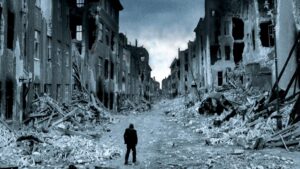
The Pianist (2002) – A Hauntingly Beautiful Tale of Survival
Roman Polanski’s The Pianist (2002) is a masterpiece that captures the horrors of World War II while portraying the resilience of the human spirit. Based on the autobiography of Władysław Szpilman, a Polish-Jewish pianist, the film presents an unflinching look at survival amidst the brutalities of the Holocaust. Starring Adrien Brody in a career-defining role, The Pianist is a poignant and deeply moving cinematic experience that leaves an indelible mark on its audience.
Plot Summary
Set in Warsaw during World War II, The Pianist follows Władysław Szpilman, a gifted pianist who enjoys a successful career as a musician before the war shatters his world. When the Nazis invade Poland in 1939, Szpilman and his family face increasing oppression under Nazi rule. They are eventually forced into the Warsaw Ghetto, where starvation, humiliation, and mass executions become a daily reality. As the war progresses, Szpilman witnesses the brutal liquidation of the ghetto but miraculously escapes deportation to a concentration camp with the help of a friend in the Jewish police.

His struggle for survival intensifies as he goes into hiding, relying on the kindness of others while experiencing unimaginable hardship. He moves from one hiding place to another, narrowly escaping capture. As the war nears its end, Szpilman is discovered by a German officer, Captain Wilm Hosenfeld. Instead of turning him in, Hosenfeld is moved by Szpilman’s talent and humanity, helping him survive until the Soviet forces liberate Warsaw.
Themes and Symbolism
One of the most striking aspects of The Pianist is its exploration of human resilience. Szpilman’s journey is one of endurance and perseverance in the face of overwhelming despair. Unlike many Holocaust films that focus on collective suffering, The Pianist narrows in on the personal experience of one man, making the horrors of war feel intensely intimate.
Music serves as a powerful symbol throughout the film. Szpilman’s talent as a pianist is not only his passion but also his lifeline. His ability to play the piano touches people across cultural and national boundaries, exemplified by Hosenfeld’s decision to spare his life. Even in his darkest moments, music remains a source of hope and a reminder of his lost humanity.
Another significant theme is the randomness of fate. Szpilman survives through a series of chance encounters and acts of kindness. His family is sent to their deaths while he is spared at the last moment. He is almost caught multiple times but manages to escape due to luck or the benevolence of others. This unpredictability mirrors the chaotic and arbitrary nature of war.

Adrien Brody’s Performance
Adrien Brody’s portrayal of Szpilman is nothing short of extraordinary. He immerses himself in the role, bringing to life the pianist’s physical and emotional suffering with haunting realism. To prepare for the part, Brody lost a significant amount of weight and isolated himself to understand Szpilman’s loneliness. His performance is marked by silent suffering; often, his eyes and body language convey more than words ever could. The scene where he plays an imaginary piano in a deserted house encapsulates his deep despair and undying love for music.
Brody’s dedication to the role earned him the Academy Award for Best Actor, making him the youngest actor ever to win in that category. His performance remains one of the most powerful depictions of Holocaust survival in cinema.
Direction and Cinematography
Roman Polanski, himself a Holocaust survivor, brings a deeply personal touch to the film. His direction is meticulous, capturing both the grand scale of destruction and the small, intimate moments of human connection. Polanski’s decision to focus on Szpilman’s survival rather than explicit violence makes the film even more harrowing; the audience experiences the terror and uncertainty just as Szpilman does.
The cinematography by Pawel Edelman is striking, using muted colors to reflect the bleakness of war-torn Warsaw. The ruined cityscapes, the empty streets, and the contrast between light and darkness create a haunting visual aesthetic. The use of long, uninterrupted shots allows viewers to absorb the devastation fully.

Historical Accuracy and Impact
The Pianist remains one of the most accurate depictions of the Holocaust in film. Many of the events portrayed, such as the Warsaw Ghetto uprising and the brutal treatment of Polish Jews, are depicted with historical precision. Szpilman’s real-life memoir, on which the film is based, provides a firsthand account, lending authenticity to the narrative.
The film does not shy away from the complexity of human nature. While it portrays the Nazis as ruthless oppressors, it also highlights individuals like Hosenfeld, who defied orders to help a Jewish man. This nuanced approach adds depth to the storytelling, moving beyond black-and-white depictions of good and evil.
Watch the Movie Here: https://youtu.be/K8DVwuXIx2E?si=6iu0QjmvnUtjs6PS
Conclusion
The Pianist is a cinematic triumph that goes beyond being a war film; it is a deeply personal and profoundly moving story about survival, resilience, and the power of art. Adrien Brody’s unforgettable performance, combined with Polanski’s masterful direction and Edelman’s evocative cinematography, make it one of the greatest films ever made about the Holocaust.
The film does not rely on melodrama or exaggerated heroism; instead, it presents an honest and unembellished portrayal of one man’s fight to live. It is a reminder of the atrocities of war and the importance of remembering history to prevent its repetition. More than two decades after its release, The Pianist continues to resonate with audiences, ensuring that Szpilman’s story is never forgotten. It is a testament to the enduring strength of the human spirit and the transcendent power of music in even the darkest times.




